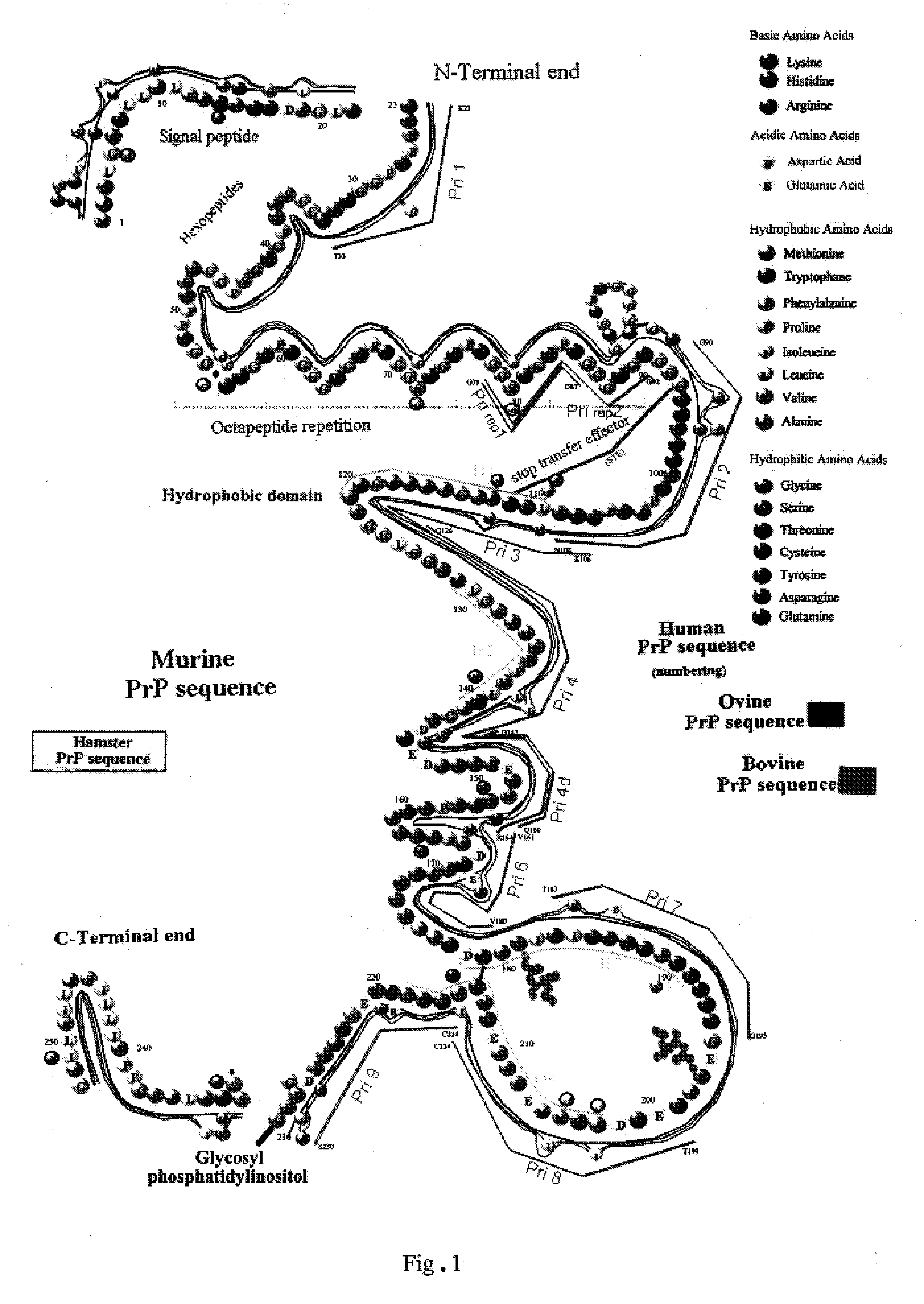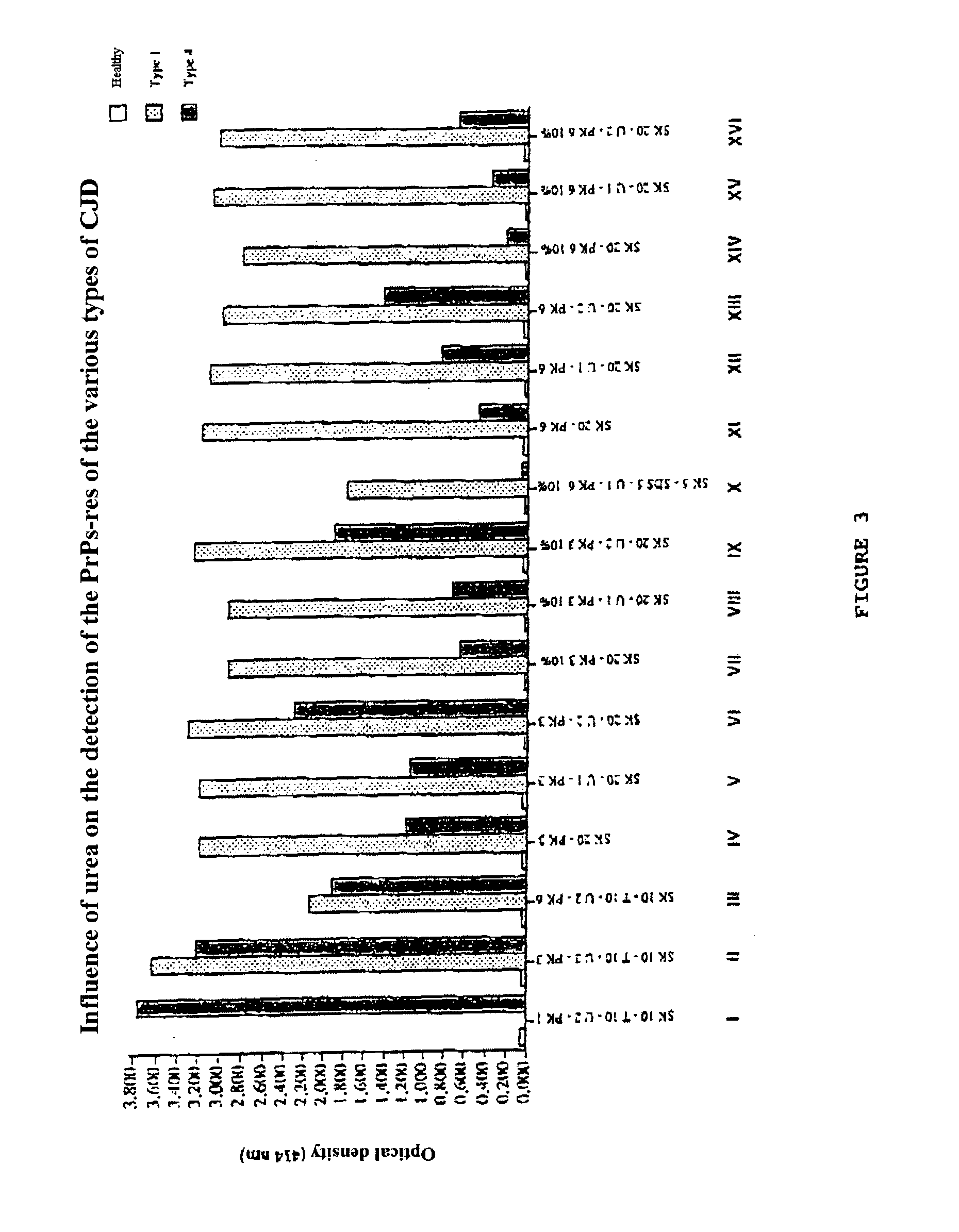Method for diagnosing a transmissible spongiform subacute encephalyopathy caused by an unconventional transmissible agent strain in a biological sample
- Summary
- Abstract
- Description
- Claims
- Application Information
AI Technical Summary
Benefits of technology
Problems solved by technology
Method used
Image
Examples
example 1
Production and Characterization of Monoclonal Antibodies Specific for the Octapeptide Motif Repeat
Synthesis and Labeling of the Peptide
[0087]A peptide representative of the PrP octapeptide motif repeat, for example the motif G-G-W-G-Q-P-H-G-G-G-W-G-Q-G-(NH2), corresponding to sequence 79–92 of the human PrP, was synthesized using an automatic synthesizer (Milligen 9050, Waters, Milford, Mich.). The peptide was covalently coupled to acetylcholinesterase (AchE) via a heterobifunctional reagent, succinimidyl 4-(N-male-imidomethyl)cyclohexane-1-carboxlate (SMCC, Calbiochem, France), as described previously for other peptides or proteins (McLaughlin et al., 1987, Grassi et al., 1989). This method involves reacting a thiol group introduced into the peptide with the maleimide function which was attached to the AchE by reaction with the SMCC. The thiol group was introduced into the peptide by reaction with N-succinimidyl S-acetylthioacetate (SATA) as described previously (McLaughlin et al.,...
example 2
Detection of PrP-res by Western Blotting
I: Treatment of the Sample
(i) Preparation of a Tissue Homogenate from the Various Biological Samples
[0091]cow BSE, sheep scrapie, human vCJD (type 4), human sporadic CJD (type 1) and corresponding negative controls
[0092]350 mg of bovine brain are taken: it is ground and homogenized at 20% (w / v) in a 5% glucose solution.
[0093]To perform the homogenization, the brain sample (350 mg) and 1.4 ml of glucose solution are introduced into tubes comprising ceramic beads, and vigorously agitated (Hybaid Ribolyser).
[0094]The positive samples were diluted in a homogenate originating from healthy brains of the corresponding species, as follows:
[0095]for sheep: to 1 / 100th
[0096]for cows: to 1 / 50th
[0097]for humans: type 1 or 4: to 1 / 40th; type 3: to 1 / 80th; type 2: to 1 / 20th
(ii) Conditions for Step (I)
[0098]A first fraction (500 μl) of homogenate at 20% obtained in (i) is incubated with 500 μl of a buffer comprising 10% sarkosyl (SK10), 10% Triton X100 (T10),...
example 3
Detection of the PrP-res with a Two-Site Immunometric Assay Using, as the Capture Antibody, a Monoclonal Antibody which Recognizes the Octapeptide Motif Repeats
[0119]To carry out a two-site immunometric assay, the pellet obtained in (iv) in example 2 is, for example, dissolved in a buffer comprising sarkosyl (0.25–1%) and urea (0.25–8 M) or SDS (0.25–1%) and urea (0.25–1 M); the sample obtained will preferably be diluted (to ¼ or to ½), after heating, with a buffer containing albumin, producing a final albumin concentration of between 0.1 and 1% (w / v), or with a buffer containing 1% deoxycholate.
[0120]The two-site immunometric assay is performed in microtitration plates containing an antibody which has been immobilized under the conditions already described for other proteins (Grassi et al., 1989). The principle thereof is as follows: the PrP analyzed is recognized by an antibody attached to the solid support (capture antibody) and by a second antibody, which recognizes another part...
PUM
| Property | Measurement | Unit |
|---|---|---|
| Temperature | aaaaa | aaaaa |
| Temperature | aaaaa | aaaaa |
| Fraction | aaaaa | aaaaa |
Abstract
Description
Claims
Application Information
 Login to View More
Login to View More - R&D
- Intellectual Property
- Life Sciences
- Materials
- Tech Scout
- Unparalleled Data Quality
- Higher Quality Content
- 60% Fewer Hallucinations
Browse by: Latest US Patents, China's latest patents, Technical Efficacy Thesaurus, Application Domain, Technology Topic, Popular Technical Reports.
© 2025 PatSnap. All rights reserved.Legal|Privacy policy|Modern Slavery Act Transparency Statement|Sitemap|About US| Contact US: help@patsnap.com



